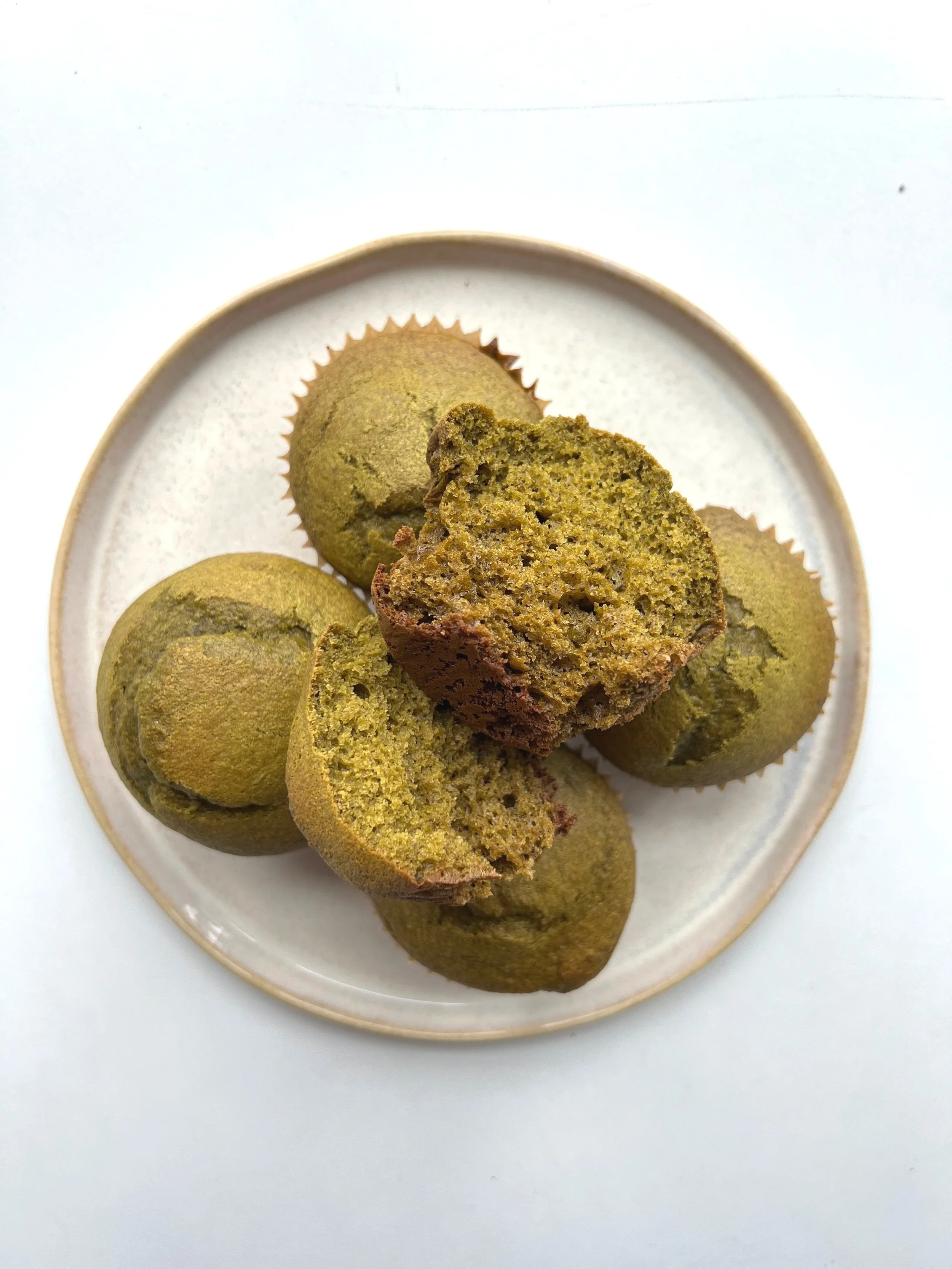Matcha Honey Oat Flour Muffins
The big switch:
As much as I love coffee and absolutely haaaate to admit it… caffeine from coffee definitely makes my anxiety worse! These days, I have my normal cup of coffee around 6-7 AM, then switch to decaf or tea after 10 AM. Occasionally I’ll cut out the coffee altogether, switching to matcha as an alternative.
I fell in love with matcha back in New York in 2018 where I couldn’t stop drinking matcha lattes at Matchaful. During this obsession I also noticed that I didn’t have the regular caffeine crash or jitters that I do with coffee, and there is a reason for that.
First off, what even is matcha?!
For all you matcha newbies, matcha is a high-grade green tea ground into powdered form. The green tea powder is whisked into hot water, instead of steeped, to form a frothy drink. Matcha actually originated in China, but now they are almost exclusively associated with and found in Japan.
There are two main types: ceremonial grade matcha and culinary grade matcha (also known as Grade A or cooking matcha). Ceremonial grade matcha is a bit superior and is best for lattes, while culinary matcha will work for this recipe. You can learn more about the difference on Art of Tea’s blog on the differences in the processing.
Matcha lattes have recently become popular in the Western world and are a beautiful form of art due to their vibrant green color (my favorite color!). They have also become a popular alternative to coffee, as the caffeine in Matcha is tolerated better in the body than the caffeine found in coffee.
Caffeine in Matcha:
Yes, matcha does contain caffeine. A typical cup of matcha will contain about 70 mg of caffeine, versus a cup of coffee can contain 100-200 mg of caffeine. Green tea leaves technically have more caffeine in them per leaf than a coffee bean per ounce, but we usually have to use more coffee beans for a cup of coffee, which is why a cup of coffee has more overall caffeine than a cup of green tea. Because matcha is a ground and concentrated form of Green Tea, it does contain more caffeine than a cup of green tea would.
Benefits of Green Tea:
Not only will a matcha latte have less caffeine than a cup of coffee, but green tea also contains an amino acid called L-Theanine, which essentially buffers the excretion of caffeine into the bloodstream. Because of the more modulated release, you won’t feel as jittery from caffeine from a matcha latte, and often results in a feeling of calm, alertness without the caffeine crash. L-Theanine also has a calming effect in itself. L-Theanine also helps with attention and focus, improves sleep, decreases stress and anxiety and has overall beneficial effects on our mental state (1).
Green tea in itself contains polyphenols, particularly one called EGCG (also called epigallocatechin gallate, but don’t try to say that 5 times quickly…). EGCG is famous for its anti-tumor effects and protection against free radicals, as well as protection against environmental toxins (2).
The Good Stuff:
Alright, so now that you know a bit more on matcha and it’s benefits, let’s get baking!!
I love this recipe I have created because there is no refined sugars and is packed with fiber from the oat flour. I also use a hack that I love for baking muffins by using my Vitamix, so there is only one kitchen item to clean up and there isn’t any mashing, whisking, or incorporating (yes, less clean up please!).
You can grab these for breakfast or a mid-day snack knowing you are eating REAL foods, incorporating plenty of fiber with the oat flour, boosting antioxidant intake and increasing focus, all without a ton of post-coffee jitters.
Makes: 12 muffins
Time to make: 30 minutes
Ingredients:
2 bananas
3 eggs
1 teaspoon vanilla
2 heaping* tablespoons matcha powder; I only use Art of Tea’s Grade A Matcha for baking. USDA organic certified and the best taste, hands down.
1/4 cup honey or maple syrup (I really like this ratio, but please use 1/2 cup if you want it to be sweeter)
1 tsp baking powder
1 tsp baking soda
1.5 cups oat flour
Sprinkle of cinnamon (optional)
Recipe:
Preheat oven to 350*F and line a muffin tin with 12 muffin liners. I am obsessed with If You Care‘s muffin liners, as they are compostable and don’t stick to the muffin (a hard combo to find!)
Add banana, eggs, honey, and vanilla in a blender and blend on low for 1 minute until smooth.
Start the blender again, and slowly add in the baking powder, baking soda, matcha, and oat flour. Blend until incorporated fully, a minute or so.
Use an ice cream scoop to evenly distribute the mixture from the blender into the tins. Optional sprinkle of cinnamon on top!
Bake for 20 minutes! I love these muffins with a dollop of almond butter on top, but you do you, babe!
This is my favorite recipe I’ve created, hands down. Please feel free to let me know what you think when you make them! I know you’ll love them just as much as I do!
Sending you matcha loveee!
XO, B
References:
1) Hidese S, Ogawa S, Ota M, et al. Effects of L-Theanine Administration on Stress-Related Symptoms and Cognitive Functions in Healthy Adults: A Randomized Controlled Trial. Nutrients. 2019;11(10):2362. Published 2019 Oct 3. doi:10.3390/nu11102362; https://www.ncbi.nlm.nih.gov/pmc/articles/PMC6836118/#:~:text=In%20humans%2C%20L%2Dtheanine%20has,including%20sleep%20quality%20%5B32%5D.
2) Chacko SM, Thambi PT, Kuttan R, Nishigaki I. Beneficial effects of green tea: a literature review. Chin Med. 2010;5:13. Published 2010 Apr 6. doi:10.1186/1749-8546-5-13; https://www.ncbi.nlm.nih.gov/pmc/articles/PMC2855614/#:~:text=The%20proliferation%20of%20hepatic%20stellate,it%20against%20oxidants%20and%20radicals.

